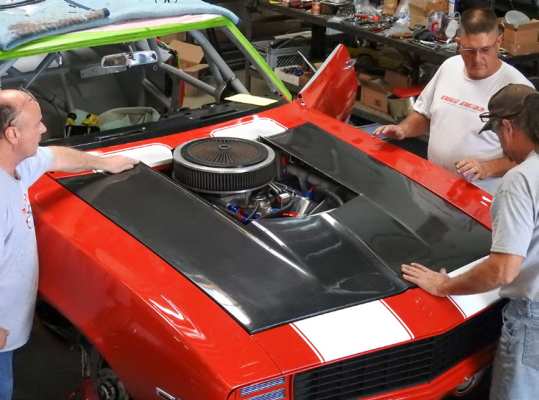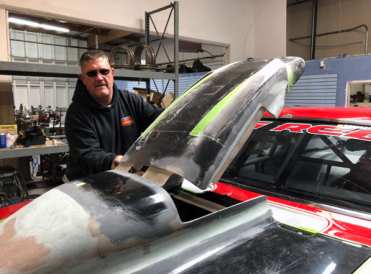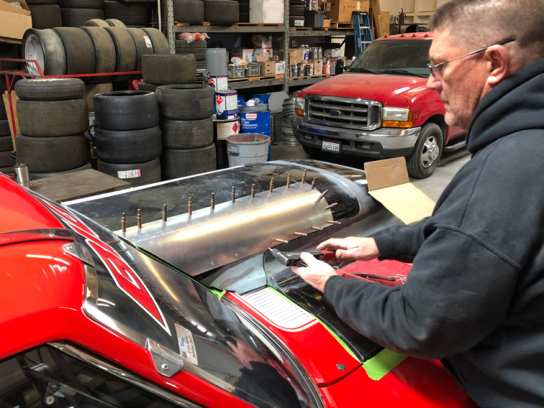HOODS

Most racing cars need to be as light as possible, which is why Dave picked up some Anvil Auto carbon-fiber parts to show Dan and RJ how much weight could be saved. Although, weight isn’t always a concern for Big Red. For instance, running at Bonneville and El Mirage required adding hundreds of extra pounds of lead to the rear of the car for traction. Using carbon-fiber parts isn’t always important. Big Red will get a carbon-fiber trunk lid for some racing events that use the factory rear spoiler. It was decided that the carbon-fiber trunk lid will not be used for the large aero spoiler.
Nothing is easy with Big Red. Parts are rarely bolt-on items. The hood was no exception. A standard two-inch cowl hood is just too short, while the four-inch cowl drag-racing hoods are too tall for RJ’s taste, and it would limit visibility going up Pikes Peak. So the mods began. Initial cutlines are laid out on the hood to preserve the scoop’s top surface and the front slope. The first cut is always the hardest to make. Measure twice, cut once! Dave carefully makes the plunge and starts cutting the carbon fiber with his angle grinder.
The intake manifold is as short as they could use without hurting power output, but the K&N air cleaner still sits too high. There are minimum heights to an air cleaner that you can install for different power output. Running a shorter element doesn’t allow for enough surface area, so the current air-filter element is as low as the setup can go. With the cutout panel sitting on the air cleaner, the additional scoop height required is obvious. The gaps in the scoop were filled, and the front slope was modified to make a smooth transition for the hood to the scoop. The finished three-inch cowl hood looks just right; Dave drilled more holes to install the hood pins.
When the hood was finished, it looked beautiful from the top. The surgical scars were visible from underneath. This isn’t a show car, it’s a race car, so there was no need to spend an extra week of labor to clean up or hide the seams under the


hood. The back room at the shop is essentially a working Big Red Camaro museum. There are spare hoods and trunk lids Big Red has used for different venues and engine setups. When the car gets swapped for a different racing setup, the parts in the back room are rotated and put into service as needed. When a new application or demand comes up that requires something other than what’s on hand, the team builds a new hood to add to the collection.
Wind-tunnel testing showed that there were gains to be made by designing a different hood scoop. In the past, the front of a pro-stock snorkel hood had been modified to be more aerodynamic. Additional work to the scoop would improve aerodynamics further. The back of the scoop needed to be extended closer to the windshield to clean up the low-pressure spot at the base of the cowl. The SCTA rule on hood scoops requires at least two inches of clearance between the back of the hood scoop and the windshield. The unlimited classes Big Red runs at top speed events, like the Texas Mile, don’t have the same restrictions about the hood scoop size and design. So it was decided that a single hood with two different
scoop extension caps would be made. First, they followed the class rules and created the SCTA-legal scoop extension.
Next, when there’s no restriction on the design of the hood scoop, they used wind-tunnel data and created the no-holds-barred hood scoop extension cap that extends to the windshield. The image of the intake manifold shows that the height of the intake does dictate the height of the scoop to an extent, but the back half of both scoops are strictly for aerodynamic purposes. Both scoops utilize three Dzus fasteners to hold the extension in place. The other reason the extensions have to be removable is because Big Red still uses stock hood hinges, so the scoop extensions hit the windshield when opening the hood and must be removed for any under hood work.
